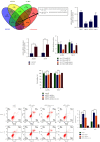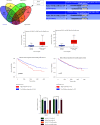The Effects of circ_000558/miR-1225-5p/ARL4C on Regulating the Proliferation of Renal Cell Carcinoma Cells
- PMID: 36778920
- PMCID: PMC9911241
- DOI: 10.1155/2023/1303748
The Effects of circ_000558/miR-1225-5p/ARL4C on Regulating the Proliferation of Renal Cell Carcinoma Cells
Abstract
Renal cell carcinoma (RCC) is one of the top ten tumors over the world. RCC is not sensitive to radiotherapy and chemotherapy. Therefore, it is necessary to find new targets for the treatment. CircRNAs are a special type of noncoding RNAs, which play important roles in many types of cancer. In this study, we found circ_000558 was upregulated in RCC cells, and it elevated the proliferation ability of RCC cells. The relationship between miR-1225-5p and circ_000558 or ARL4C was predicted via circBank and circular RNA interactome and confirmed by dual-luciferase reporter assay. Then, the effects of circ_000558/miR-1225-5p/ARL4C on RCC cell proliferation and apoptosis were assessed by CCK-8 assay. The results revealed that the knockdown of ARL4C significantly reduced RCC cell proliferation and overexpression of circ_000558 could significantly induce RCC cell proliferation after miR-1225-5p treatment further promoted the inhibitory ability of ARL4C knockdown. Overall, our study suggested that circ_000558/miR-1225-5p/ARL4C network was related to the RCC cell proliferation. This finding could provide new targets for the treatment and prognosis of RCC.
Copyright © 2023 Ling Xia et al.
Conflict of interest statement
The authors declare that they have no conflicts of interest.
Figures






Similar articles
-
CircRNA SCARB1 Promotes Renal Cell Carcinoma Progression Via Mir- 510-5p/SDC3 Axis.Curr Cancer Drug Targets. 2020;20(6):461-470. doi: 10.2174/1568009620666200409130032. Curr Cancer Drug Targets. 2020. PMID: 32271695
-
Expression profiling of circular RNA reveals a potential miR-145-5p sponge function of circ-AFF2 and circ-ASAP1 in renal cell carcinoma.Am J Transl Res. 2023 Jan 15;15(1):82-98. eCollection 2023. Am J Transl Res. 2023. PMID: 36777845 Free PMC article.
-
Circ_0035483 Functions as a Tumor Promoter in Renal Cell Carcinoma via the miR-31-5p-Mediated HMGA1 Upregulation.Cancer Manag Res. 2021 Jan 25;13:693-706. doi: 10.2147/CMAR.S282806. eCollection 2021. Cancer Manag Res. 2021. PMID: 33531839 Free PMC article.
-
Circ_0000274 contributes to renal cell carcinoma progression by regulating miR-338-3p/NUCB2 axis and JAK1/STAT3 pathway.Transpl Immunol. 2022 Oct;74:101626. doi: 10.1016/j.trim.2022.101626. Epub 2022 May 13. Transpl Immunol. 2022. PMID: 35569717
-
Circ-CSPP1 knockdown suppresses hepatocellular carcinoma progression through miR-493-5p releasing-mediated HMGB1 downregulation.Cell Signal. 2021 Oct;86:110065. doi: 10.1016/j.cellsig.2021.110065. Epub 2021 Jun 26. Cell Signal. 2021. PMID: 34182091 Review.
Cited by
-
Elevating microRNA levels by targeting biogenesis with steric-blocking antisense oligonucleotides.RNA. 2024 Nov 18;30(12):1543-1553. doi: 10.1261/rna.080021.124. RNA. 2024. PMID: 39255995 Free PMC article.
-
Role of the circular RNAs/microRNA/messenger RNA axis in renal cell carcinoma: From gene regulation to metabolism and immunity.iScience. 2025 Mar 11;28(4):112183. doi: 10.1016/j.isci.2025.112183. eCollection 2025 Apr 18. iScience. 2025. PMID: 40212586 Free PMC article. Review.
-
ARL4C is associated with epithelial-to-mesenchymal transition in colorectal cancer.BMC Cancer. 2023 May 26;23(1):478. doi: 10.1186/s12885-023-10958-4. BMC Cancer. 2023. PMID: 37237373 Free PMC article.
References
-
- Zhai T., Zhang B., Qu Z., Chen C. Elevated visceral obesity quantified by CT is associated with adverse postoperative outcome of laparoscopic radical nephrectomy for renal clear cell carcinoma patients. International Urology and Nephrology . 2018;50(5):845–850. doi: 10.1007/s11255-018-1858-1. - DOI - PubMed
LinkOut - more resources
Full Text Sources

